Using Si, Al and Fe as Tracers for Source Apportionment of Air Pollutants in Lake Baikal Snowpack
Abstract
1. Introduction
2. Materials and Methods
2.1. Study Area
2.2. Sampling and Chemical Determinations
2.3. Data Processing
3. Results and Discussion
3.1. Chemical Composition of Snow Meltwater and Data Variability Analysis
3.2. Chemical Composition of Potential Source Emissions
3.3. Source Apportionment
3.4. Evaluation of Source Apportionment Results
4. Conclusions
Supplementary Materials
Author Contributions
Funding
Conflicts of Interest
References
- Watson, J.G.; Chen, L.W.A.; Chow, J.C.; Doraiswamy, P.; Lowenthal, D.H. Source apportionment: Findings from the U.S. supersites program. J. Air Waste Manag. Assoc. 2008, 58, 265–288. [Google Scholar] [CrossRef]
- Viana, M.; Kuhlbusch, T.A.J.; Querol, X.; Alastuey, A.; Harrison, R.M.; Hopke, P.K.; Winiwarter, W.; Vallius, M.; Szidat, S.; Prévôt, A.S.H.; et al. Source apportionment of particulate matter in Europe: A review of methods and results. J. Aerosol Sci. 2008, 39, 827–849. [Google Scholar] [CrossRef]
- Hopke, P.K. The application of receptor modeling to air quality data. Pollut. Atmos. 2010, 91–109. Available online: https://www.appa.asso.fr/wp-content/uploads/2020/02/Hopke_2010.pdf (accessed on 12 March 2020).
- Belis, C.A.; Karagulian, F.; Larsen, B.R.; Hopke, P.K. Critical review and meta-analysis of ambient particulate matter source apportionment using receptor models in Europe. Atmos. Environ. 2013, 69, 94–108. [Google Scholar] [CrossRef]
- Belis, C.A.; Larsen, B.; Amato, F.; El Haddad, I.; Favez, O.; Harrison, R.; Hopke, P.; Nava, S.; Paatero, P.; Prevot, A.; et al. European Guide on Air Pollution Source Apportionment with Receptor Models; JRC Reference Report EUR 26080 EN; Publications Office of the European Union: Luxembourg, 2014; ISBN 978-92-79-32513-7. [Google Scholar] [CrossRef]
- Belis, C.A.; Favez, O.; Mircea, M.; Diapouli, E.; Manousakas, M.-I.; Vratolis, S.; Gilardoni, S.; Paglione, M.; Decesari, S.; Mocnik, G.; et al. European Guide on Air Pollution Source Apportionment with Receptor Models–Revised Version 2019; EUR 29816 EN; Publications Office of the European Union: Luxembourg, 2019; ISBN 978-92-76-09001-4. [Google Scholar] [CrossRef]
- Aloyan, A.E.; Arutyunyan, V.O.; Yermakov, A.N.; Zagaynov, V.A.; Mensink, C.; De Ridder, K.; Van de Vel, K.; Deutsch, F. Modeling the regional dynamics of gaseous admixtures and aerosols in the areas of lake baikal (Russia) and antwerp (Belgium). Aerosol Air Qual. Res. 2012, 12, 707–721. [Google Scholar] [CrossRef]
- Obolkin, V.A.; Potemkin, V.L.; Makukhin, V.L.; Khodzher, T.V.; Chipanina, E.V. Long-range transport of plumes of atmospheric emissions from regional coal power plants to the South Baikal water basin. Atmos. Ocean. Opt. 2017, 30, 360–365. [Google Scholar] [CrossRef]
- Khodzher, T.V.; Zhamsueva, G.S.; Zayakhanov, A.S.; Dementeva, A.L.; Tsydypov, V.V.; Balin, Y.S.; Penner, I.E.; Kokhanenko, G.P.; Nasonov, S.V.; Klemasheva, M.G.; et al. Ship-based studies of aerosol-gas admixtures over lake baikal basin in summer 2018. Atmos. Ocean. Opt. 2019, 32, 434–441. [Google Scholar] [CrossRef]
- Belozertseva, I.A.; Vorobyeva, I.B.; Vlasova, N.V.; Lopatina, D.N.; Yanchuk, M.S. Snow pollution in Lake Baikal water area in nearby land areas. Water Res. 2017, 44, 471–484. [Google Scholar] [CrossRef]
- Belozertseva, I.A.; Vorobyeva, I.B.; Vlasova, N.V.; Janchuk, M.S.; Lopatina, D.N. Chemical composition of snow water of the water area of the southern hollow of Lake Baikal. Int. J. Appl. Fundam. Res. 2016, 10, 263–272. (In Russian) [Google Scholar]
- Belozertseva, I.A.; Vorobeva, I.B.; Vlasova, N.V.; Yanchuk, M.S.; Lopatina, D.N. Pollution of snow on the water area of the average hollow of Lake Baikal and the adjacent territory. Adv. Curr. Nat. Sci. 2016, 11, 96–105. (In Russian) [Google Scholar]
- Belozertseva, I.A.; Vorobeva, I.B.; Vlasova, N.V.; Yanchuk, M.S.; Lopatina, D.N. Pollution of snow on the water area of the northern hollow of Lake Baikal and the adjacent territory. Adv. Curr. Nat. Sci. 2016, 9, 97–103. (In Russian) [Google Scholar]
- Netsvetaeva, O.G.; Golobokova, L.P.; Obolkin, V.A.; Khodzher, T.V. Multiyear research of atmospheric deposition: Case study at the Listvyanka monitoring station (Southern Pribaikalye. Russia). Proc. SPIE 2018, 10833, 108333T. [Google Scholar] [CrossRef]
- Onishchuk, N.A.; Netsvetaeva, O.G.; Khodzher, T.V. The heavy metal content in precipitation at air monitoring sites Irkutsk and Listvyanka (Baikal Region. Russia). Proc. SPIE 2019, 11208, 112083I. [Google Scholar] [CrossRef]
- Yunker, M.B.; Macdonald, R.W. Composition and origins of polycyclic aromatic hydrocarbons in the Mackenzie River and on the Beaufort Sea shelf. Arctic 1995, 48, 118–129. [Google Scholar] [CrossRef]
- Zhou, F.; Guo, H.; Liu, L. Quantitative identification and source apportionment of anthropogenic heavy metals in marine sediment of Hong Kong. Environ. Geol. 2007, 53, 295. [Google Scholar] [CrossRef]
- Li, Y.; Gao, H.; Mo, L.; Kong, Y.; Lou, I. Quantitative assessment and source apportionment of metal pollution in soil along Chao River. Desalin. Water Treat. 2013, 51, 4010–4018. [Google Scholar] [CrossRef]
- Liu, Y.; Chen, L.; Huang, Q.H.; Li, W.Y.; Tang, Y.J.; Zhao, J.F. Source apportionment of polycyclic aromatic hydrocarbons (PAHs) in surface sediments of the Huangpu River. Shanghai. China. Sci. Total Environ. 2009, 407, 2931–2938. [Google Scholar] [CrossRef]
- Jin, Y.; O’Connor, D.; Ok, Y.S.; Tsang, D.C.W.; Liu, A.; Hou, D. Assessment of sources of heavy metals in soil and dust at children’s playgrounds in Beijing using GIS and multivariate statistical analysis. Environ. Int. 2019, 124, 320–328. [Google Scholar] [CrossRef]
- Shen, F.; Mao, L.; Sun, R.; Du, J.; Tan, Z.; Ding, M. Contamination evaluation and source identification of heavy metals in the sediments from the Lishui River Watershed. Southern China. Int. J. Environ. Res. Public Health 2019, 16, 336. [Google Scholar] [CrossRef] [PubMed]
- Chen, H.Y.; Teng, Y.G.; Wang, J.S. Source apportionment of polycyclic aromatic hydrocarbons (PAHs) in surface sediments of the Rizhao coastal area (China) using diagnostic ratios and factor analysis with nonnegative constraints. Sci. Total Environ. 2012, 414, 293–300. [Google Scholar] [CrossRef]
- Guan, Q.; Wang, F.; Xu, C.; Pan, N.; Lin, J.; Zhao, R.; Yang, Y.; Luo, H. Source apportionment of heavy metals in agricultural soil based on PMF: A case study in Hexi Corridor. Northwest China. Chemosphere 2018, 193, 189–197. [Google Scholar] [CrossRef]
- Hu, N.J.; Huang, P.; Liu, J.H.; Ma, D.Y.; Shi, H.F.; Mao, J.; Liu, Y. Characterization and source apportionment of polycyclic aromatic hydrocarbons (PAHs) in sediments in the Yellow River Estuary. China. Environ. Earth Sci. 2014, 71, 873–883. [Google Scholar] [CrossRef]
- Larsen, R.K.; Baker, J.E. Source apportionment of polycyclic aromatic hydrocarbons in the urban atmosphere: A comparison of three methods. Environ. Sci. Technol. 2003, 37, 1873–1881. [Google Scholar] [CrossRef]
- Cai, K.; Li, C. Street dust heavy metal pollution source apportionment and sustainable management in a typical city—Shijiazhuang China. Int. J. Environ. Res. Public Health 2019, 16, 2625. [Google Scholar] [CrossRef]
- Song, Y.; Li, H.; Li, J.; Mao, C.; Ji, J.; Yuan, X.; Li, T.; Ayoko, G.A.; Frost, R.L.; Feng, Y. Multivariate linear regression model for source apportionment and health risk assessment of heavy metals from different environmental media. Ecotoxicol. Environ. Saf. 2018, 165, 555–563. [Google Scholar] [CrossRef]
- Henry, R.C. Multivariate receptor modeling by N-dimensional edge detection. Chemom. Intell. Lab. Syst. 2003, 65, 179–189. [Google Scholar] [CrossRef]
- Semenov, M.Y.; Marinaite, I.I.; Bashenkhaeva, N.V.; Zhuchenko, N.A.; Khuriganova, O.I.; Molozhnikova, E.V. Polycyclic aromatic hydrocarbons in a small eastern siberian river: Sources. delivery pathways and behavior. Environ. Earth Sci. 2016, 75, 1–12. [Google Scholar] [CrossRef]
- Khalili, N.R.; Scheff, P.A.; Holsen, T.M. PAH source fingerprints for coke ovens, diesel and, gasoline engines, highway tunnels, and wood combustion emissions. Atmos. Environ. 1995, 29, 533–542. [Google Scholar] [CrossRef]
- Watson, J.G.; Robinson, N.F.; Chow, J.C.; Henry, R.C.; Kim, B.M.; Pace, T.G.; Meyer, E.L.; Nguyen, Q. The USEPA/DRI chemical mass balance receptor model. Environ. Softw. 1990, 5, 38–49. [Google Scholar] [CrossRef]
- Demir, S.; Saral, A. A new modification to the chemical mass balance receptor model for volatile organic compound source apportionment. Clean-Soil Air Water 2011, 39, 891–899. [Google Scholar] [CrossRef]
- Wang, G.A.Y.; Jiang, H.; Fu, Q.; Zheng, B. Modeling the source contribution of heavy metals in surficial sediment and analysis of their historical changes in the vertical sediments of a drinking water reservoir. J. Hydrol. 2015, 520, 37–51. [Google Scholar] [CrossRef]
- Pipalatkar, P.; Khaparde, V.V.; Gajghate, D.G.; Bawase, M.A. Source apportionment of PM2.5 using a CMB model for a centrally located Indian city. Aerosol Air Qual. Res. 2014, 14, 1089–1099. [Google Scholar] [CrossRef]
- Hopke, P.K. Theory and application of atmospheric source apportionment. In Air Quality and Ecological Impacts: Relating Sources to Effects; Allan, H.L., Ed.; Elsevier: Amsterdam, The Netherlands, 2009; pp. 1–33. [Google Scholar]
- Robinson, A.L.; Donahue, N.M.; Rogge, W.F. Photochemical oxidation and changes in molecular composition of organic aerosol in the regional context. J. Geophys. Res. 2006, 111. [Google Scholar] [CrossRef]
- Kastner, M.; Breuer-Jammali, M.; Mahro, B. Enumeration and characterization of the soil microflora from hydrocarbon-contaminated soil sites able to mineralize polycyclic aromatic hydrocarbons (PAH). Appl. Microbiol. Biotechnol. 1995, 41, 267–273. [Google Scholar] [CrossRef]
- Guthrie, E.A.; Pfaender, F.K. Reduced pyrene bioavailability in microbially active soils. Environ. Sci. Technol. 1998, 32, 501–508. [Google Scholar] [CrossRef]
- Wang, C.Y.; Gao, X.L.; Sun, Z.G.; Qin, Z.J.; Yin, X.N.; He, S.J. Evaluation of the diagnostic ratios for the identification of spilled oils after biodegradation. Environ. Earth Sci. 2013, 68, 917–926. [Google Scholar] [CrossRef]
- Tsapakis, M.; Stephanou, E.G. Collection of gas and particle semi-volatile organic compounds: Use of an oxidant denuder to minimize polycyclic aromatic hydrocarbons degradation during high-volume air sampling. Atmos. Environ. 2003, 37, 4935–4944. [Google Scholar] [CrossRef]
- Ravindra, K.; Sokhi, R.; Van Grieken, R. Atmospheric polycyclic aromatic hydrocarbons: Source attribution. emission factors and regulation. Atmos. Environ. 2008, 42, 2895–2921. [Google Scholar] [CrossRef]
- Tobiszewski, M.; Namiesnik, J. PAH diagnostic ratios for the identification of pollution emission sources. Environ. Pollut. 2012, 162, 110–119. [Google Scholar] [CrossRef]
- Semenov, M.Y.; Marinaite, I.I.; Golobokova, L.P.; Khuriganova, O.I.; Khodzher, T.V.; Semenov, Y.M. Source apportionment of polycyclic aromatic hydrocarbons in Lake Baikal water and adjacent air layer. Chem. Ecol. 2017, 33, 977–990. [Google Scholar] [CrossRef]
- Semenov, M.; Marinaite, I.; Zhuchenko, N.; Silaev, A.; Vershinin, K.; Semenov, Y. Revealing the factors affecting occurrence and distribution of polycyclic aromatic hydrocarbons in water and sediments of Lake Baikal and its tributaries. Chem. Ecol. 2018, 34, 901–916. [Google Scholar] [CrossRef]
- Christensen, E.R.; Li, A.; Ab Razak, I.A.; Rachdawong, P.; Karls, J.F. Sources of polycyclic aromatic hydrocarbons in sediments of the Kinnickinnic River. Wisconsin. J. Gt. Lakes Res. 1997, 23, 61–73. [Google Scholar] [CrossRef]
- Turnlund, J.R. The use of stable isotopes in mineral nutrition research. J. Nutr. 1989, 119, 7–14. [Google Scholar] [CrossRef]
- Hogan, J.F.; Blum, J.D. Tracing hydrologic flow paths in a small forested watershed using variations in (87)Sr(/8)6Sr. [Ca]/[Sr]. [Ba]/[Sr] and delta O-18. Water Resour. Res. 2003, 39, 1282. [Google Scholar] [CrossRef]
- Xue, D.; Botte, J.; De Baets, B.; Accoe, F.; Nestler, A.; Taylor, P.; Van Cleemput, O.; Berglund, M.; Boeckx, P. Present limitations and future prospects of stable isotope methods for nitrate source identification in surface- and groundwater. Water Res. 2009, 43, 1159–1170. [Google Scholar] [CrossRef] [PubMed]
- Brownlow, R.; Lowry, D.; Fisher, R.E.; France, J.L.; Lanoisellé, M.; White, B.; Nisbet, E.G. Isotopic ratios of tropical methane emissions by atmospheric measurement. Glob. Biogeochem. Cycles 2017, 31, 1408–1419. [Google Scholar] [CrossRef]
- Glibert, P.M.; Middelburg, J.J.; McClelland, J.W.; Vander Zanden, J.M. Stable isotope tracers: Enriching our perspectives and questions on sources. fates. rates. and pathways of major elements in aquatic systems. Limnol. Oceanogr. 2019, 64, 950–981. [Google Scholar] [CrossRef]
- Jung, H.; Koh, D.C.; Kim, Y.S.; Jeen, S.W.; Lee, J. Stable isotopes of water and nitrate for the identification of groundwater flowpaths: A review. Water 2020, 12, 138. [Google Scholar] [CrossRef]
- Cicchella, D.; De Vivo, B.; Lima, A.; Albanese, S.; McGill, R.A.R.; Parrish, R.R. Heavy metal pollution and Pb isotopes in urban soils of Napoli. Italy. Geochem. Explor. Environ. Anal. 2008, 8, 103–112. [Google Scholar] [CrossRef]
- Nazarpour, A.; Watts, M.J.; Madhani, A.; Elahi, S. Source. Spatial distribution and pollution assessment of Pb. Zn. Cu. and Pb. Isotopes in urban soils of Ahvaz city. A semi-arid metropolis in southwest Iran. Sci. Rep. 2019, 9, 5349. [Google Scholar] [CrossRef]
- Das, A.; Krishna, K.V.S.S.; Kumar, R.M.; Saha, C.; Sengupta, S.; Ghosh, J.G. Lead isotopic ratios in source apportionment of heavy metals in the street dust of Kolkata, India. Environ. Sci. Technol. 2018, 15, 159. [Google Scholar] [CrossRef]
- Vecchia, A.M.D.; de Lena, J.C.; Ladeira, A.C.Q. Application of multivariate statistic of U. Th and Pb concentrations and Pb isotopic signatures in the assessment of geogenic and anthropogenic sources in a U-mineralized area. J. Geosci. Environ. Prot. 2019, 7, 1–12. [Google Scholar] [CrossRef]
- Ault, W.U.; Senechal, R.G.; Erlebach, W.E. Isotopic composition as a natural tracer of lead in the environment. Environ. Sci. Technol. 1970, 4, 305–313. [Google Scholar] [CrossRef]
- Christophersen, N.; Neal, C.; Hooper, R.P.; Vogt, R.D.; Andersen, S. Modelling streamwater chemistry as a mixture of soil water end-members - a step towards second-generation acidification models. J. Hydrol. 1990, 116, 307–320. [Google Scholar] [CrossRef]
- Kokunov, V.L. The dependence of qualitative and technological characteristics of coals from Ircha-Borodinskoye deposit of Kansk-Achinsk basin on their petrologic composition. Bull. Tomsk Polytech. Inst. 1971, 177, 108–113. (In Russian) [Google Scholar]
- Bogdanov, A.V.; Shatrova, A.S.; Tyukalova, O.V.; Shkrabo, A.I. An environmentally-friendly technology for the processing of accumulated colloidal sludge-lignin precipitates in the Baikalsk pulp and paper mill. Izv. Vuzov. Prikl. Khimiya Biotekhnol. [Proc. Univ. Appl. Chem. Biotechnol.] 2018, 8, 126–134. (In Russian) [Google Scholar] [CrossRef]
- Krylov, D.A. Heavy metals in fly ash of TES. Evergy Econ. Tech. Ecol. 2010, 4, 44–50. (In Russian) [Google Scholar]
- Sorokina, I.D.; Dresvyannikov, A.F. Synthesis and assessment of using iron-aluminum coagulant for water purification. Bull. Kazan Technol. Univ. 2009, 4, 146–158. (In Russian) [Google Scholar]
- Nikitin, A.N.; Ermakova, E.V. Sludge wastes from fuel-fired power plants—Sources of air pollution and potential resources of mineral commodities. Bull. TulGU. Phys. Sect. 2006, 6, 96–111. [Google Scholar]
- Filimonova, L.M.; Parshin, A.V.; Bychinskii, V.A. Air pollution assessment in the area of aluminum production by snow geochemical survey. Russ. Meteorol. Hydrol. 2015, 40, 691–698. (In Russian) [Google Scholar] [CrossRef]
- Kaiser, H.F. The application of electronic computers to factor analysis. Educ. Psychol. Meas. 1960, 20, 141–151. [Google Scholar] [CrossRef]
- Liu, F.; Williams, M.; Caine, N. Source waters and flow paths in a seasonally snow-covered catchment, Colorado Front Range, USA. Water Resour. Res. 2004, 40. [Google Scholar] [CrossRef]
- Ahmad, I.; Khan, R.; Ishaq, M.; Khan, H.; Ismail, M.; Gul, K.; Ahmad, W. Catalytic pyrolysis of used engine oil over coal ash into fuel-like products. Energy Fuels 2016, 30, 204–218. [Google Scholar] [CrossRef]
- Li, F.; Fang, Y. Ash fusion characteristics of a high aluminum coal and its modification. Energy Fuels 2016, 30, 2925–2931. [Google Scholar] [CrossRef]
- Al-Degs, Y.S.; Ghrir, A.; Khoury, H.; Walker, G.M.; Sunjuk, M.; Al-Ghouti, M.A. Characterization and utilization of fly ash of heavy fuel oil generated in power stations. Fuel Process. Technol. 2014, 123, 41–46. [Google Scholar] [CrossRef]
- Aslam, Z.; Hussein, I.A.; Shawabkeh, R.A.; Parvez, M.A.; Ihsanullah, A.W. Adsorption kinetics and modeling of H2S by treated waste oil fly ash. J. Air Waste Manag. 2019, 69, 246–257. [Google Scholar] [CrossRef]
- Al-Malack, M.H.; Abdullah, G.M.; Al-Amoudi, O.S.B.; Bukhari, A.A. Stabilization of indigenous Saudi Arabian soils using fuel oil flyash. J. King Saud Univ. Eng. Sci. 2016, 28, 165–173. [Google Scholar] [CrossRef]
- Pitman, R.M. Wood ash use in forestry–A review of the environmental impacts. For. Int. J. For. Res. 2006, 79, 563–588. [Google Scholar] [CrossRef]
- Kalembkiewicz, J.; Galas, D.; Sitarz-Palczak, E. The physicochemical properties and composition of biomass ash and evaluating directions of its applications. Pol. J. Environ. Stud. 2018, 27, 2593–2603. [Google Scholar] [CrossRef]
- Van Ryssen, J.B.J.; Ndlovu, H. Wood ash in livestock nutrition: 1. Factors affecting the mineral composition of wood ash. Appl. Anim. Husb. Rural Dev. 2018, 11, 53–61. [Google Scholar]
- Kvande, H.; Drablos, P.A. The aluminum smelting process and innovative alternative technologies. J. Occup. Environ. Med. 2014, 56, 23–32. [Google Scholar] [CrossRef] [PubMed]
- Aarhaug, T.A.; Ratvik, A.P. Aluminium primary production off-gas composition and emissions: An overview. JOM 2019, 71, 2966–2977. [Google Scholar] [CrossRef]
- Jeong, G.Y.; Kim, J.Y.; Seo, J.; Kim, G.M.; Jin, H.C.; Chun, Y. Long-range transport of giant particles in Asian dust identified by physical, mineralogical, and meteorological analysis. Atmos. Chem. Phys. 2014, 14, 505–521. [Google Scholar] [CrossRef]
- Jeong, G.Y. Mineralogy and geochemistry of Asian dust: Dependence on migration path, fractionation, and reactions with polluted air. Atoms. Chem. Phys. 2020. [Google Scholar] [CrossRef]
- Sha, Y.; Shi, Z.; Liu, X.; An, Z. Distinct impacts of the Mongolian and Tibetan Plateaus on the evolution of the East Asian monsoon. J. Geophys. Res. Atmos. 2015, 120, 4764–4782. [Google Scholar] [CrossRef]
- Saneev, B.G.; Ivanova, I.; Maisyuk, E.P.; Tuguzova, T.F.; Ivanov, R.A. Energeticheskaya infrastructura tsentralnoy ecologicheskoy zony Baikalskoi prirodnoy territorii: Vozdeystviye na prirodnuyu sredu i puti ego snizheniya [The power generation infrastructure in the central ecological zone of the Baikal natural territory: The environmental impact and ways to mitigate it]. Geogr. Nat. Res. 2016, 5, 218–224. (In Russian) [Google Scholar]
- Popovicheva, O.B.; Kireeva, E.D.; Steiner, S.; Rothen-Rutishauser, B.; Persiantseva, N.M.; Timofeev, M.A.; Shonija, N.K.; Comte, P.; Czerwinski, J. Microstructure and chemical composition of diesel and biodiesel particle exhaust. Aerosol Air Qual. Res. 2014, 14, 1392–1401. [Google Scholar] [CrossRef]
- Bagi, S.; Sharma, V.; Patel, M.; Aswath, P.B. Effects of diesel soot composition and accumulated vehicle mileage on soot oxidation characteristics. Energy Fuels 2016, 30, 8479–8490. [Google Scholar] [CrossRef]
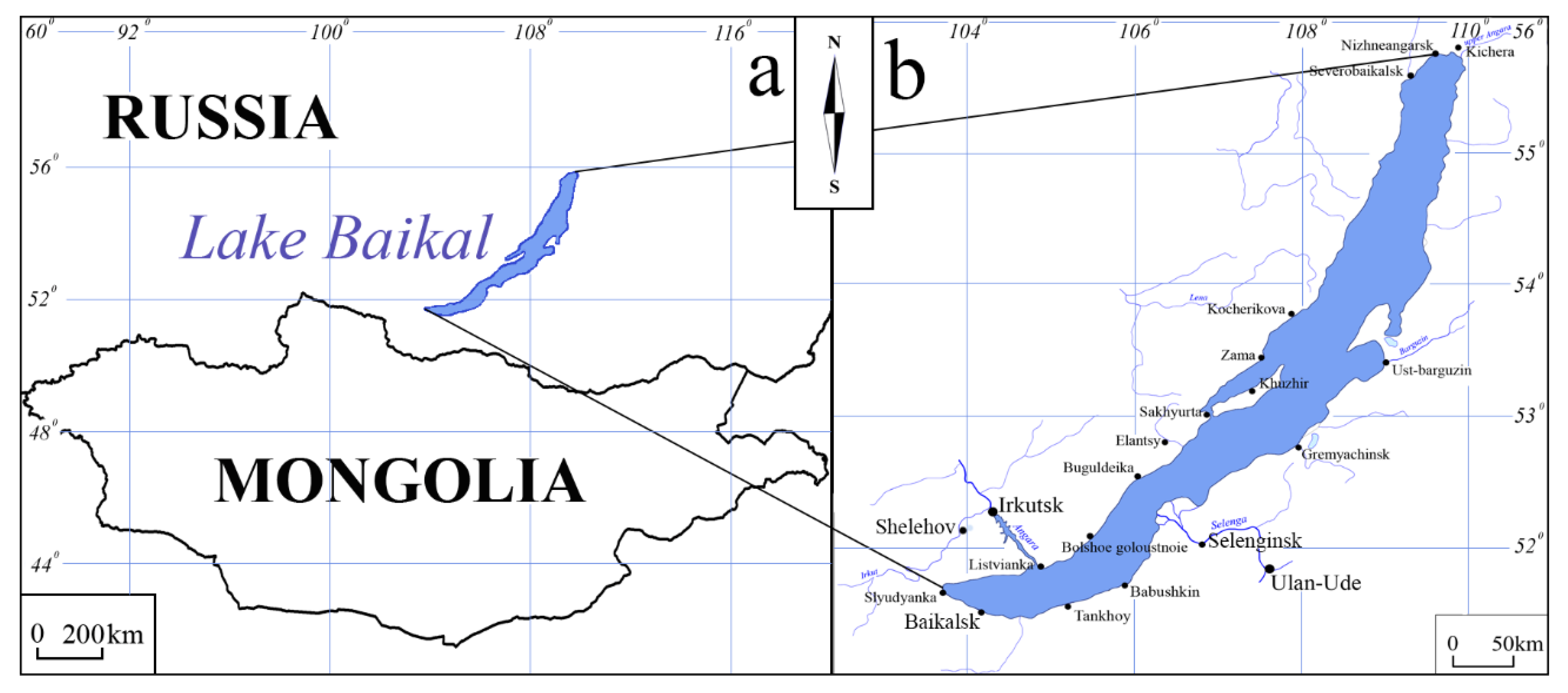
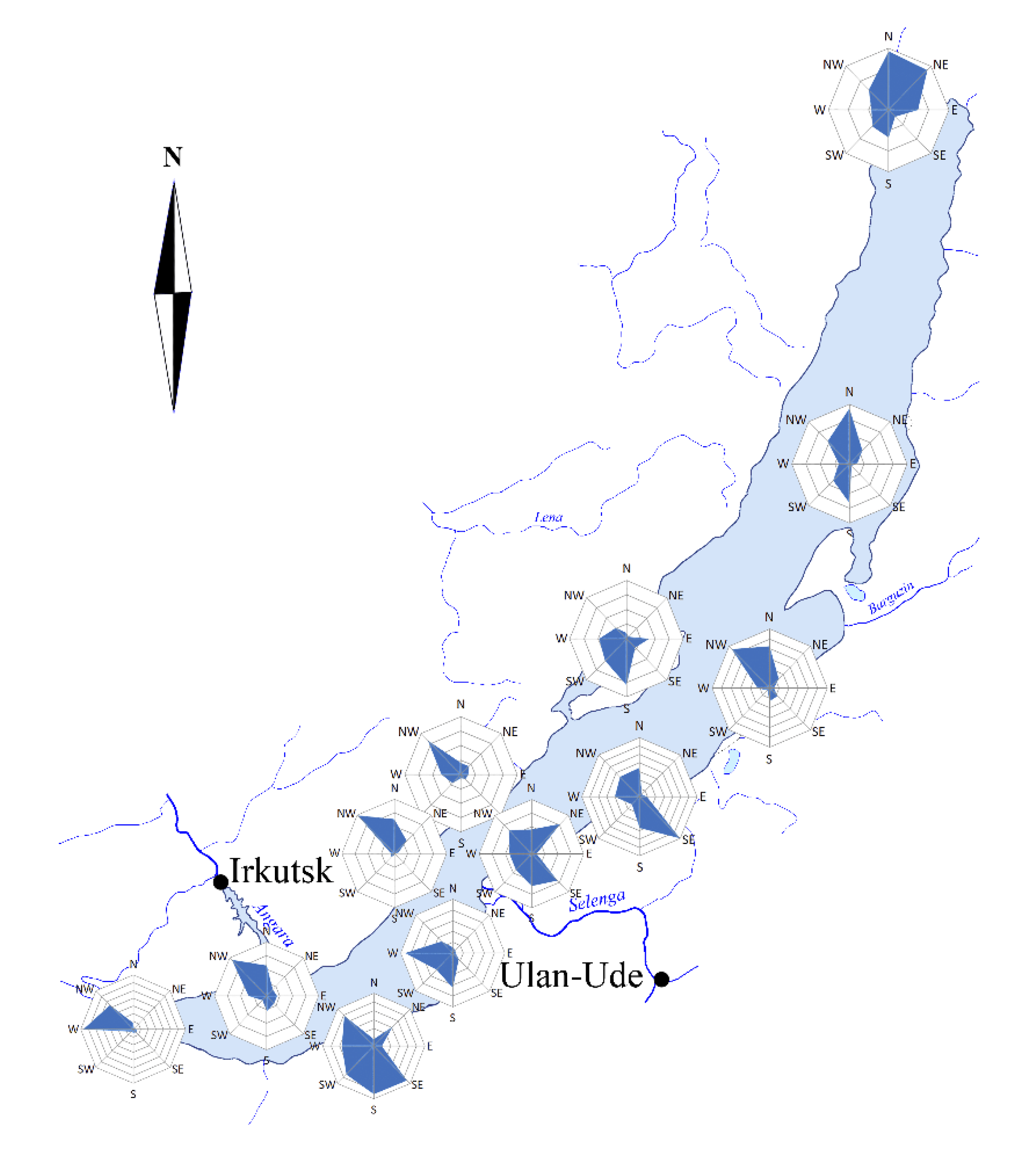
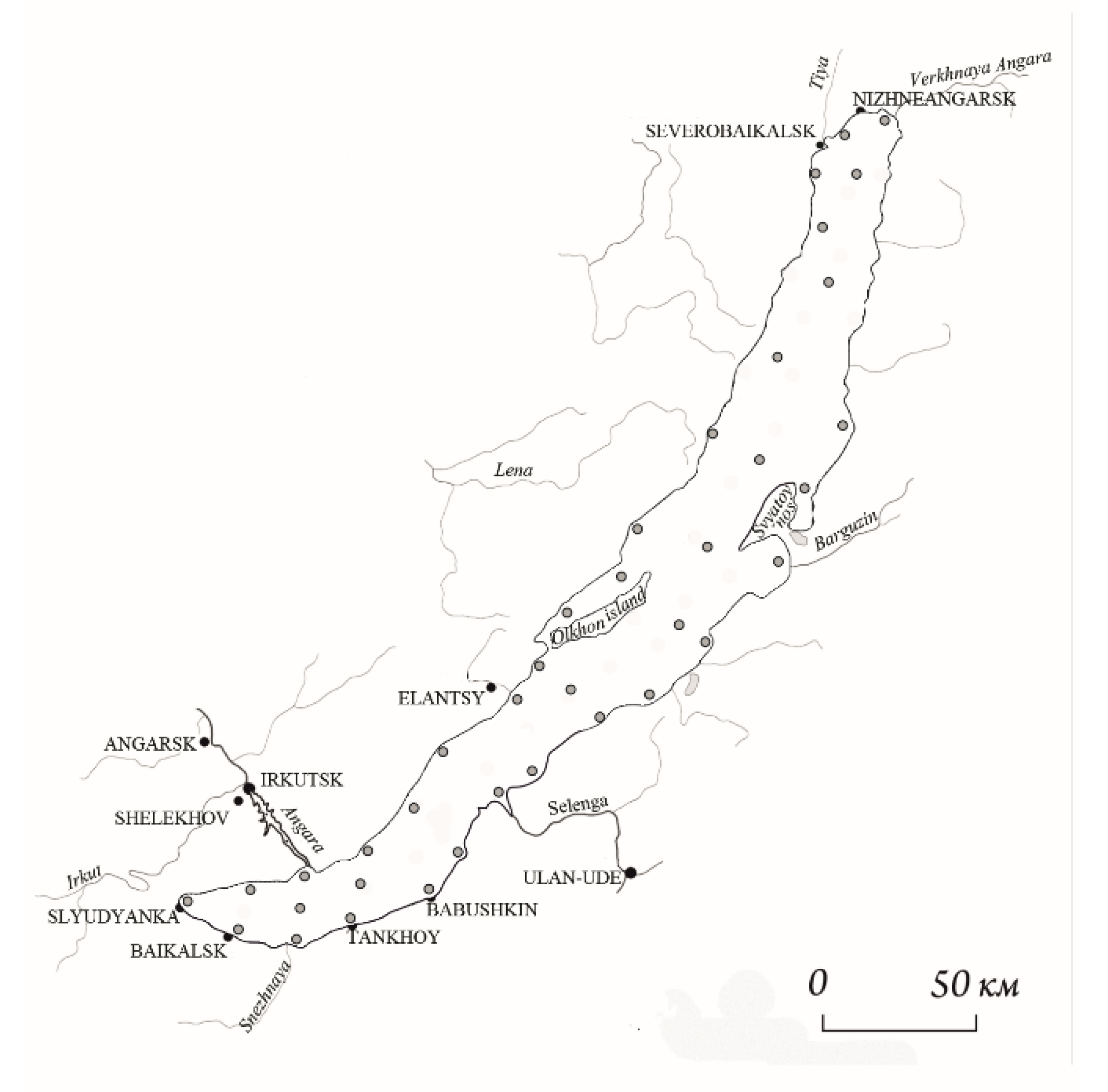

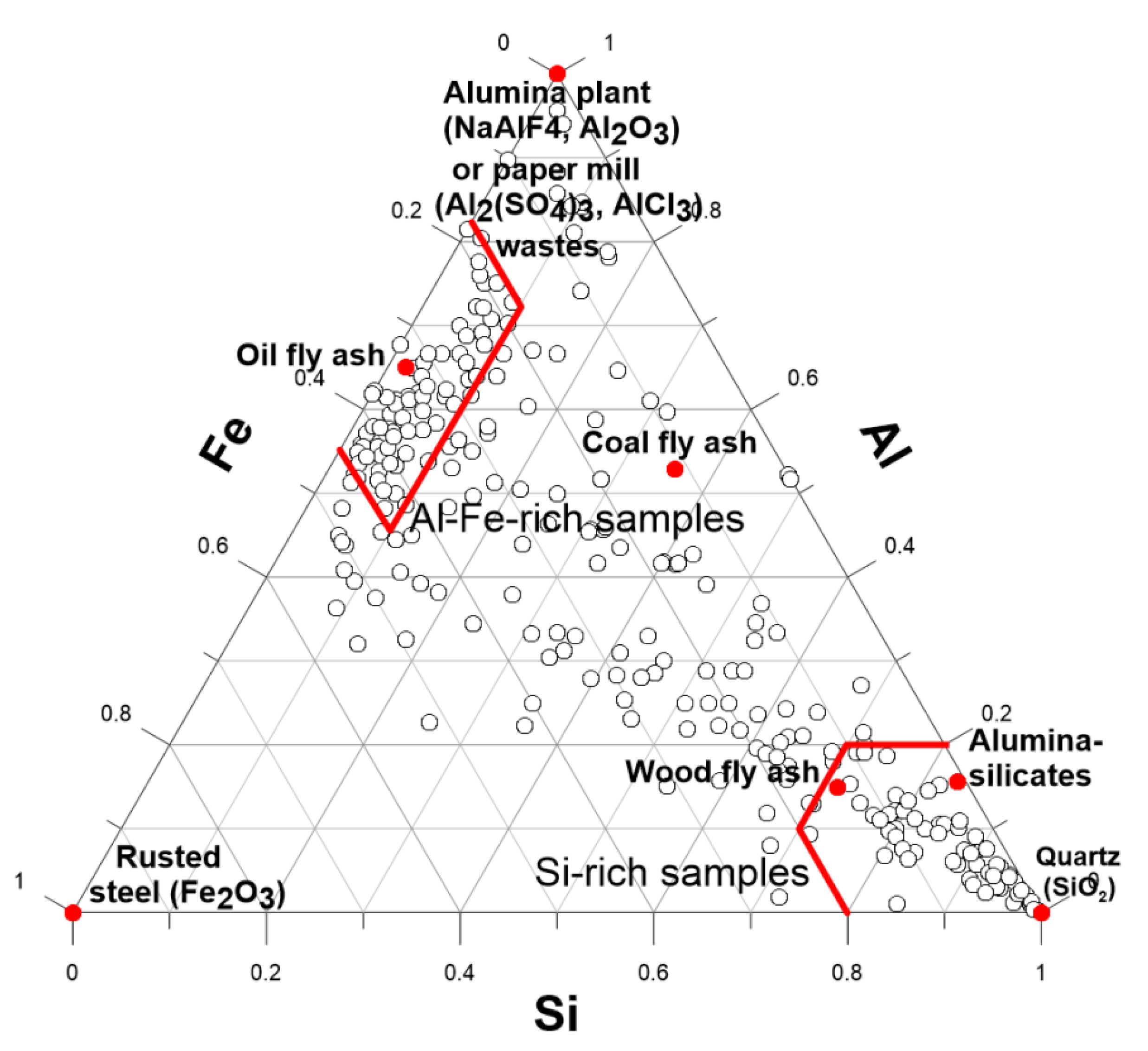
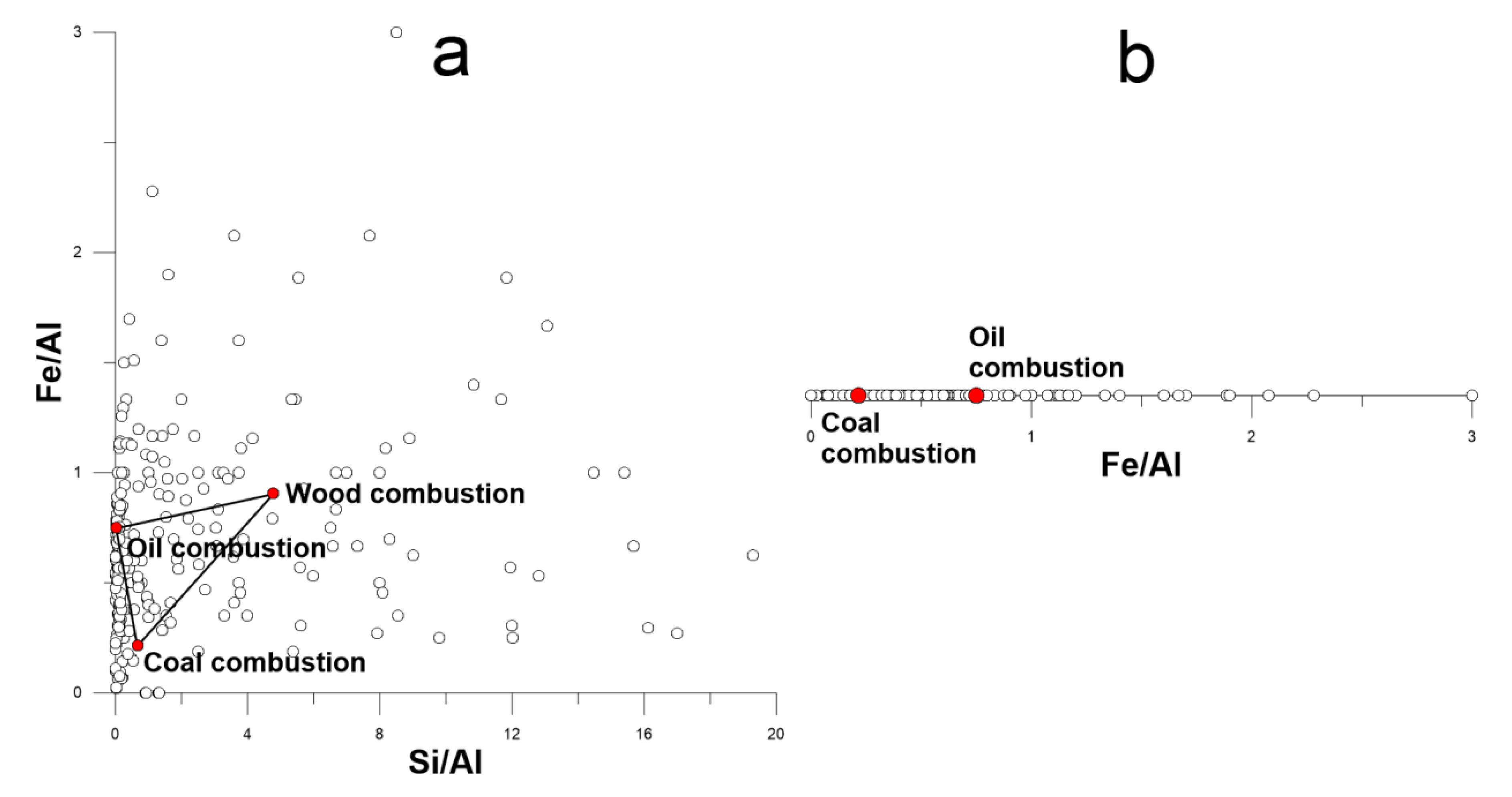



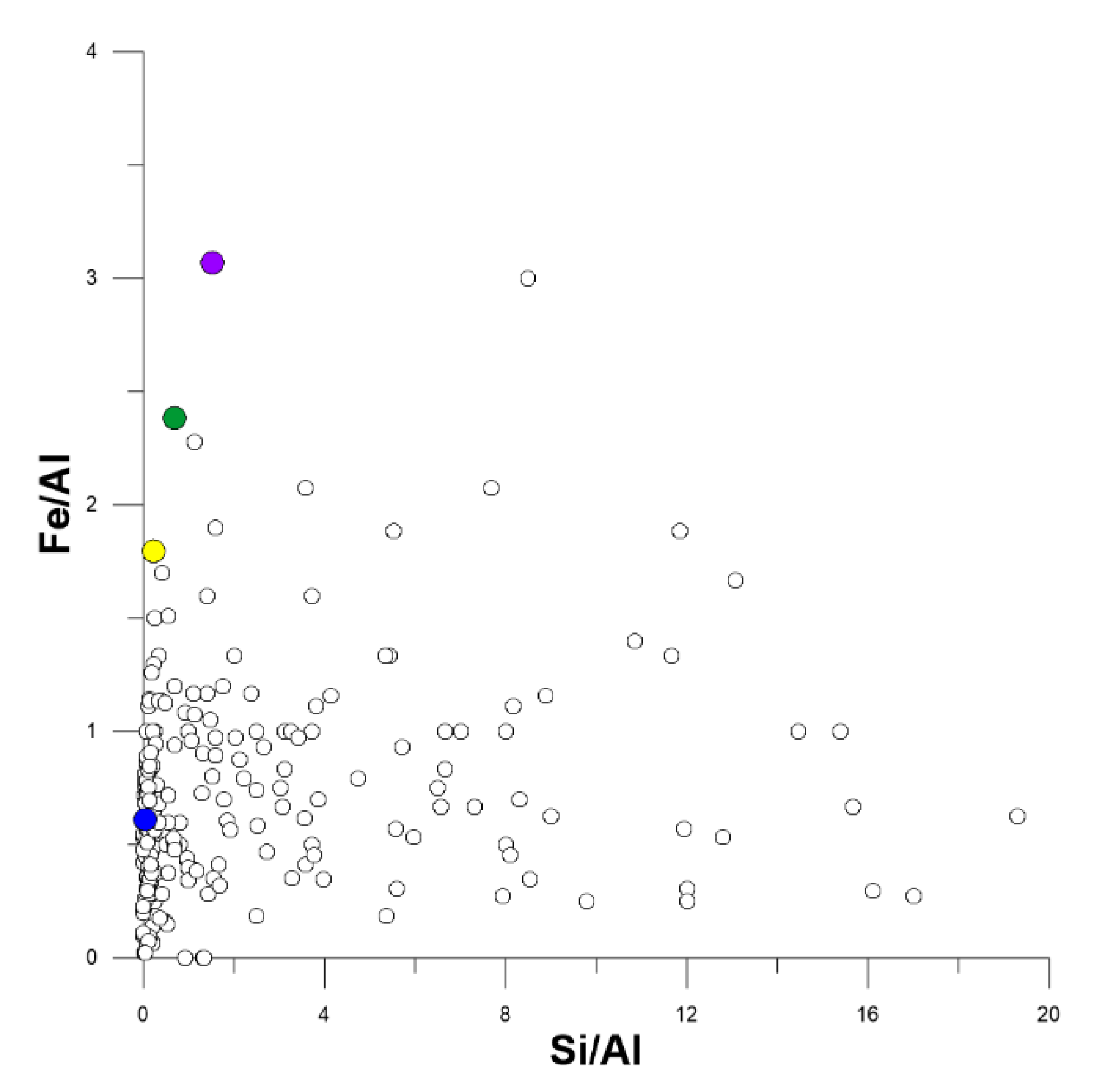
| Element | Minimum | Maximum | Mean ± Std. * | Error of Mean |
|---|---|---|---|---|
| µg/L | ||||
| Si | 3 | 6001 | 83 ± 11 | 1 |
| Al | 2 | 177 | 31 ± 37 | 3 |
| Fe | 2 | 60 | 23 ± 24 | 2 |
| Mo | 2 | 32 | 8 ± 7 | 0.5 |
| Mn | 1 | 39 | 11 ± 9 | 0.6 |
| Sr | 2 | 37 | 12 ± 15 | 1 |
| PC Number | Eigenvalue | % of Total Variance Explained | Cumulative Eigenvalue | Cumulative % of Variance |
|---|---|---|---|---|
| 1 | 2.52 | 41.94 | 2.52 | 41.94 |
| 2 | 1.18 | 19.72 | 3.70 | 61.66 |
| 3 | 0.99 | 16.46 | 4.69 | 78.12 |
| 4 | 0.63 | 10.52 | 5.32 | 88.63 |
| 5 | 0.51 | 8.46 | 5.83 | 97.09 |
| 6 | 0.17 | 2.91 | 6.00 | 100.00 |
© 2020 by the authors. Licensee MDPI, Basel, Switzerland. This article is an open access article distributed under the terms and conditions of the Creative Commons Attribution (CC BY) license (http://creativecommons.org/licenses/by/4.0/).
Share and Cite
Semenov, M.Y.; Silaev, A.V.; Semenov, Y.M.; Begunova, L.A. Using Si, Al and Fe as Tracers for Source Apportionment of Air Pollutants in Lake Baikal Snowpack. Sustainability 2020, 12, 3392. https://doi.org/10.3390/su12083392
Semenov MY, Silaev AV, Semenov YM, Begunova LA. Using Si, Al and Fe as Tracers for Source Apportionment of Air Pollutants in Lake Baikal Snowpack. Sustainability. 2020; 12(8):3392. https://doi.org/10.3390/su12083392
Chicago/Turabian StyleSemenov, Mikhail Yu., Anton V. Silaev, Yuri M. Semenov, and Larisa A. Begunova. 2020. "Using Si, Al and Fe as Tracers for Source Apportionment of Air Pollutants in Lake Baikal Snowpack" Sustainability 12, no. 8: 3392. https://doi.org/10.3390/su12083392
APA StyleSemenov, M. Y., Silaev, A. V., Semenov, Y. M., & Begunova, L. A. (2020). Using Si, Al and Fe as Tracers for Source Apportionment of Air Pollutants in Lake Baikal Snowpack. Sustainability, 12(8), 3392. https://doi.org/10.3390/su12083392





